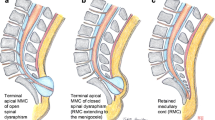Abstract
Introduction
A retained medullary cord (RMC) is a rare dysraphic malformation, recently described as a late arrest of secondary neurulation. RMC is also a severely tethering lesion. The critical role of intraoperative neurophysiology to safely manage a RMC has been only anecdotally reported.
Case report
We describe the case of a RMC in a 1.5-year-old child with Currarino syndrome. At surgery, an apparently normal-looking spinal cord, stretched and tethered by a lipoma to the level of S2-S3, was observed. The border between the functional conus and the non functional RMC was defined through neurophysiological mapping. The cord was sharply interrupted at this level and untethered. A specimen was sent for pathology, which confirmed the presence of glial and neural elements. The post-operative neurological exam was normal.
Conclusion
Neurosurgical procedure for RMC should only be rendered with intraoperative neurophysiological mapping, as the anatomical judgment would not suffice to allow a safe cutting of these “normal-looking” neural structures.




Similar content being viewed by others
Abbreviations
- RMC:
-
Retained medullary cord
- ION:
-
Intraoperative neurophysiology
- SEPs:
-
Somatosensory-evoked potentials
- mMEPs:
-
Muscle motor-evoked potentials
- BCR:
-
Bulbocavernosus reflex
- CMAPs:
-
Compound muscle action potentials
References
Deletis V, Vodusek DB (1997) Intraoperative recording of the bulbocavernous reflex. Neurosurgery 40:88–93
Hoving EW, Haitsma E, Oude Ophuis CM, Journée HL (2010) The value of intraoperative neurophysiological monitoring in tethered cord surgery. Childs Nerv Syst 27:1445–1452
James HE, Mulcahy JJ, Walsh JW, Kaplan GW (1979) Use of anal sphincter electromyography during operations on the conus medullaris and sacral nerve roots. Neurosurgery 4:521–523
Kothbauer KF, Deletis V (2010) Intraoperative neurophysiology of the conus medullaris and cauda equina. Childs Nerv Syst 26:247–253
Krassioukov AV, Sarjeant R, Arkia H, Fehlings MG (2004) Multimodality intraoperative monitoring during complex lumbosacral procedures: indications, techniques, and long-term follow-up review of 61 consecutive cases. J Neurosurg Spine 1:243–253
Krieger D, Sclabassi RJ (1995) Neurophysiologic assessment in the management of spinal dysraphism. Neurosurg Clin N Am 6:219–230
Kumar GS, Rajshekhar V, Babu KS (2006) Intraoperative mapping of sacral nervous system (S2-4). Br J Neurosurg 20:396–402
Legatt AD, Schroeder CE, Gill B, Goodrich JT (1992) Electrical stimulation and multichannel EMG recording for identification of functional neural tissue during cauda equina surgery. Childs Nerv Syst 8:185–189
Pang D, Zovickian J, Oviedo A (2009) Long-term outcome of total and near-total resection of spinal cord lipomas and radical reconstruction of the neural placode: part I-surgical technique. Neurosurgery 65:511–528, discussion 528-9
Pang D, Zovickian J, Moes GS (2011) Retained medullary cord in humans: late arrest of secondary neurulation. Neurosurgery 68:1500–1519, discussion 1519
Pouratian N, Elias WJ, Jane JA Jr, Phillips LH 2nd, Jane JA Sr (2010) Electrophysiologically guided untethering of secondary tethered spinal cord syndrome. Neurosurg Focus 29:E3
Rodi Z, Vodusek DB (2001) Intraoperative monitoring of the bulbocavernosus reflex: the method and its problems. Clin Neurophysiol 112:879–883
Sala F, Krzan MJ, Deletis V (2002) Intraoperative neurophysiological monitoring in pediatric neurosurgery: why, when, how? Childs Nerv Syst 18:264–287
von Koch CS, Quinones-Hinojosa A, Gulati M, Lyon R, Peacock WJ, Yingling CD (2002) Clinical outcome in children undergoing tethered cord release utilizing intraoperative neurophysiological monitoring. Pediatr Neurosurg 37:81–86
Author information
Authors and Affiliations
Corresponding author
Rights and permissions
About this article
Cite this article
Sala, F., Barone, G., Tramontano, V. et al. Retained medullary cord confirmed by intraoperative neurophysiological mapping. Childs Nerv Syst 30, 1287–1291 (2014). https://doi.org/10.1007/s00381-014-2372-0
Received:
Accepted:
Published:
Issue Date:
DOI: https://doi.org/10.1007/s00381-014-2372-0




